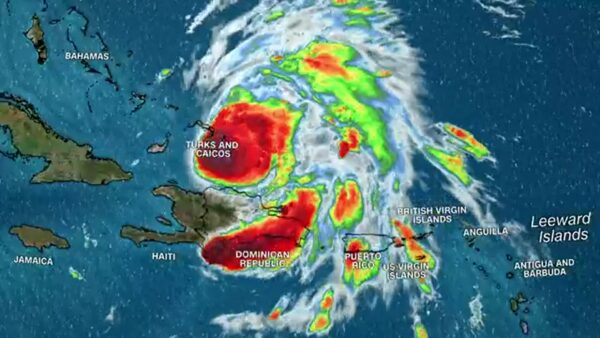
(CNN) — Hurricane Fiona is continuing its ruinous path Tuesday after devastating Puerto Rico with flooding rain then ripping through the Dominican Republic, where more than a million people were left without running water and dozens of homes were destroyed.
Nearly 800 people were brought to safety by emergency workers in the Dominican Republic, according to the country’s emergency management director of operations, Juan Manuel Mendez. At least 519 people were taking refuge in the country’s 29 shelters Monday, he said.
The eye of the hurricane slammed into the nation early Monday, battering communities with maximum sustained winds of 90 miles per hour, the National Hurricane Center said. That’s after the storm wreaked havoc across Puerto Rico Sunday and into Monday, leaving the US territory in a blackout and bringing destruction not seen on the island since Hurricane Maria in 2017, officials said.
At least three people have died the severe weather, including one in the French territory of Guadeloupe and two in Puerto Rico, according to officials.
In Puerto Rico, a 58-year-old man was swept away by a swollen river behind his home in Comerío and another man in his 30s died in a fire accident that occurred while he was trying to put gasoline in his generator while it was turned on, officials said.
As of Monday afternoon, at least 1,018,564 customers across the Dominican Republic had no access to running water as 59 aqueducts were out of service and several others were only partially functioning, according to Jose Luis German Mejia, a national emergency management official.
Some were also without electricity Monday as 10 electric circuits went offline, emergency management officials said. It’s unclear how many people are impacted by the outages.
Heavy rainfall continued to soak eastern regions of the Dominican Republic Monday evening and life-threatening flooding is expected to continue into Tuesday.
Fiona intensified into a Category 3 storm as it moved away from the Dominican Republic’s northern coast early Tuesday with sustained winds whipped up to 115 miles per hour with gusts as strong as 130 miles per hour, according to the hurricane center.
The designation now classifies Fiona as a major hurricane, the first of the Atlantic season.
But the most powerful stages of the storm may be yet to come, as Fiona is expected to escalate into as high as Category 4 by the time it is expected to pass near or to the west of Bermuda on Thursday night.
The storm’s center will likely continue to push northward, moving near or to the east of Turks and Caicos on Tuesday, according to the forecast.
Hurricane conditions will likely be seen in Turks and Caicos Tuesday and by late Monday or early Tuesday the Bahamas are anticipated to be under tropical storm conditions, the hurricane center said.
Even as a tropical storm warning was lifted over Puerto Rico, the island continued to be lashed by the hurricane’s outer bands, soaking regions already struggling under dangerous flooding and destruction.
As Tuesday marks the 5-year anniversary of Hurricane Maria’s catastrophic landfall, some who lived through the 2017 crisis say Fiona’s flooding destruction could be even more severe.
Juan Miguel Gonzalez, a business owner in Puerto Rico told CNN that his neighborhood had still not finished its recovery from Maria when Fiona struck. But this time, he says, the flooding brought even deeper damage to their homes.
“A lot of people — more than (during) Maria — lost their houses now … lost everything in their houses because of the flooding,” Gonzalez told CNN’s Leyla Santiago. “Maria was tough winds. But this one, with all the rain, it just destroyed everything in the house.”
Most of the damage inflicted on the island is rain-related, Puerto Rico Governor Pedro Pierluisi told CNN Monday evening.
More than 1.2 million customers are still in the dark as of early Tuesday, according to estimates from PowerOutage.us, which notes updated information on restoration efforts is limited.
Pierluisi said he hopes it will be “a matter of days” to restore power for most customers. The company that oversees the territory’s power grid, LUMA Energy, previously said transmission line outages were contributing to the blackout, and on Monday said it had restored power to over 100,000 customers.
Critically, power was restored to one of Puerto Rico’s most vital medical facilities on Monday, according to the territory’s health secretary Dr. Carlos Mellado López.
“The power system at all the hospitals in the Medical Center Complex has been restored,” Mellado said in a Sunday night tweet. “Our patients are safe and receiving the medical care they need.”
Many of those without power also have no water, as rain and flooding impacts to filtration systems left only about 35% of customers with water service as of Monday, the governor said.
Emergency crews battled against unrelenting rain to rescue approximately 1,000 people as of midday Monday, said Maj. Gen. José Reyes, adjutant general of the Puerto Rico National Guard.
In addition to the hundreds of Puerto Rican National Guard members aiding in rescue and recovery efforts, the White House said Monday that President Joe Biden told Pierluisi during a phone call that federal support will increase in the coming days.
“As damage assessments are conducted, the President said that number of support personnel will increase substantially,” the White House said.
New York Governor Kathy Hochul also announced the state would send 100 state troopers to assist relief efforts in Puerto Rico. She also said teams from New York Power Authority are available to help with power restoration.
